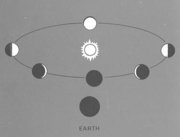Geocentric model
|
|
The geocentric model (in Greek: geo = earth and centron = centre) of the universe is a paradigm which places the Earth at its center. Common in ancient Greece after the discovery of the approximately spherical shape of Earth, it was believed by both Aristotle and Ptolemy. Most Greeks assumed that the Sun, Moon, stars, and planets orbit Earth. Similar ideas were held in ancient China.
The geocentric model assumes a spherical Earth; thus it is not the same as the older flat Earth model. Also, according to this model, the orbits were perfectly circular and not elliptical.
The geocentric model held sway into the early modern age; from the late 16th century onward it was gradually replaced by the heliocentric model of Copernicus, Galileo and Kepler due to the simplicity and predictive accuracy of that newer model.
In this model, a set of fifty-five concentric crystalline spheres were considered to hold the Sun, the planets, and the stars. These spheres (called deferents) revolved at varying velocities around the Earth to account for the rising and setting of celestial objects every day.
However, this simple model of the revolutions of spheres could not explain all astronomical phenomena. In particular, certain celestial bodies were observed to wander across the fixed fields of stars over time; mostly they wandered in one direction, but occasionally they seemed to reverse course. These "wandering stars" were given the name "planet", based on the Greek word "planetes", meaning "wanderer". To explain this strange retrogradation, Aristotle claimed that planets were attached, not directly to deferents, but to smaller spheres called epicycles. The epicycles were themselves attached to the deferents; the simultaneous revolution of both sets of spheres created an occasional apparent reversal of the planets' motions across the skies of the Earth.
Ptolemy further modified this model to more accurately reflect observations by placing epicycles upon epicycles, creating an extraordinarily complicated--but fairly accurate--depiction of the cosmos. He also displaced the Earth from the center of the universe, claiming that, while Earth was enclosed by the celestial spheres, the spheres actually revolved around a point called an eccentric, which was near the Earth but not quite on it.
This elaborate theoretical system stemmed largely from one important observation. If Earth did move, then one ought to be able to observe the shifting of the fixed stars due to parallax. In short, the shapes of the constellations should change considerably over the course of a year. In reality, the stars are so very much further away than the Sun and the planets that this motion (which does exist) is undetectable without careful telescopic observations using modern equipment, but the lack of any observable parallax was considered the death of any non-geocentric theory for a thousand years.
This view of a geocentric universe held sway for well over a millennium, but was seriously challenged by the publication of Copernicus's De Revolutionibus Orbium Coelestium in 1543, which posited that the Earth and the other planets instead revolved around the Sun. It would still be held, however, for many years, as at the time the Copernican system did not offer better experimental results than the geocentric system.
In December 1610, Galileo Galilei used his telescope to show that Venus went through phases, just like the Moon. This observation was incompatible with the Ptolemaic system. In the 4th century BC, Heraclides Ponticus had already proposed that both Venus and Mercury orbited the Sun rather than Earth. The observation by Galileo led to interest in the more accurate (but still geocentric) Tychonian system, and the heliocentric Copernican system, which both explain how the Sun is commonly in between the Earth and Venus (see Phases of Venus).
At this time, geocentrism is rejected in scientific and popular opinion; and it is believed that the Sun is at the centre of the solar system, but not the universe (see Heliocentrism), so a better term for the modern view is geokineticism (i.e. that the earth moves, without asserting anything about the center of motion). However, Sir Fred Hoyle wrote:
- The relation of the two pictures [geocentricity and heliocentricity] is reduced to a mere coordinate transformation and it is the main tenet of the Einstein theory that any two ways of looking at the world which are related to each other by a coordinate transformation are entirely equivalent from a physical point of view ... . Today we cannot say that the Copernican theory is “right” and the Ptolemaic theory “wrong” in any meaningful physical sense.1
A small number of people still advance a geocentric model (see the article on modern geocentrism, which also discusses the modern scientific point of view in detail). These people tend to be of a religious mindset and sometimes Creationists, because without the concept of God willing to create the Earth at the center of the universe, it would appear mysterious for it to be so. However, most Creationists do believe in the geokinetic model.2 (http://www.answersingenesis.org/tj/v15/i2/geocentrism.asp)
The geocentric (Ptolemaic) model of the solar system is also of interest to planetarium makers, as for technical reasons a Ptolemaic-type motion for the planet light apparatus has some advantages over a Copernican-type motion.
See also
Notes
de:Geozentrisches Weltbild et:Geotsentriline maailmasüsteem fr:Géocentrisme it:Sistema geocentrico lv:Ģeocentrisms nl:Geocentrisme no:Geosentrisme ja:天動説 pl:Teoria geocentryczna pt:Geocentrismo

